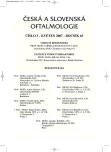Comparison of the Two Methods, LASIK and ICL in Mild and High Hyperopia Correction – Part One
Srovnání metody LASIK a implantace ICL při korekci střední a vysoké hyperopie I. část
Problematika chirurgické korekce hyperopie je komplikovaná. Nejčastěji užívanou metodou jsou rohovkové laserové zákroky (PRK, LASIK), fakické nitrooční čočky nebo extrakce čiré čočky (CLE).
Cílem práce bylo zhodnotit a porovnat dlouhodobé pooperační výsledky dvou typů refrakčních zákroků při korekci střední a vysoké hyperopie: LASIKu a implantace ICL (fakické zadněkomorové čočky). Autoři hodnotili soubor 37 očí 20 pacientů průměrného věku 36,3 let ± 11,8 (SD) a sledovací dobou 28,1 měsíce ± 10,2 (SD) po LASIKu a 21 očí 13 pacientů průměrného věku 28,6 let ± 6,1 (SD) a sledovací dobou 30,4 měsíce ± 20,9 (SD) po implantaci ICL. Srovnávali výslednou nekorigovanou a nejlépe korigovanou zrakovou ostrost a pooperační refrakci (do dálky a blízka) a jejich vývoj v čase. Prokázali statisticky významné zlepšení nekorigované zrakové ostrosti (UCVA) pooperačně oproti předoperačním hodnotám u obou metod (LASIK i ICL) (p < 0,05). Lepší výsledná UCVA byla dosažena metodou implantace ICL (p < 0,05). BCVA se zlepšila pouze po implantaci ICL (p > 0,05). U hyperopického LASIKu došlo naopak ke zhoršení oproti BCVA před zákrokem (p > 0,05). Změny BCVA nebyly statisticky významné. Autoři dále prokázali lepší výslednou sférickou refrakci do dálky (p < 0,05 v 1. a 2. roce) i do blízka (p < 0,05 v 1. a 2. roce) u metody ICL oproti hypermetropickému LASIKu. Stabilita pooperační refrakce byla po celou sledovací dobu vyšší po implantaci ICL. U laserového zákroku byla patrná trvalá regrese pooperační refrakce. Hodnota výsledné cylindrické refrakce byla rovněž nižší v souboru ICL (p > 0,05). Stabilita pooperační cylindrické refrakce byla vyšší po celou dobu sledování u metody ICL.
Při srovnání nitroočního zákroku (ICL) s laserovou metodou LASIK vykazovala implantace ICL lepší výslednou nekorigovanou a korigovanou zrakovou ostrost a stabilnější pooperační refrakci.
Klíčová slova:
hyperopie, LASIK, ICL
Authors:
M. Horáčková; E. Vlková; V. Loukotová; Z. Hlinomazová
Authors‘ workplace:
Oftalmologická klinika LF MU a FN, Brno pracoviště Bohunice
přednosta prof. MUDr. Eva Vlková, CSc.
Published in:
Čes. a slov. Oftal., 63, 2007, No. 3, p. 143-153
Overview
The problems of hyperopia surgical correction are complicated. The most used methods are corneal laser treatments (PRK and LASIK), phakic intraocular lenses or clear lens extraction (CLE). The aim of the study was to evaluate and to compare long-term postoperative results of two types of refractive procedures in mild and high hyperopia correction: LASIK and ICL (phakic intraocular posterior chamber contact lens) implantation. The authors evaluated a group of 37 eyes of 20 patients; the average age was 36.3 years ± 11.8 (SD) and the followup period 28.1 months ± 10.2 (SD) after LASIK procedure, and group of 21 eyes of 13 patients; the average age was 28.6 years ± 6.1 (SD) and the follow-up period 30.4 months ± 20.9 (SD) after the ICL implantation. The final uncorrected (UCVA) and best-corrected visual acuity (BCVA) and postoperative refractive error (for far and near) and their development in time were compared. They found statistically significant improvement of the UCVA postoperatively comparing to the preoperative values in both methods (LASIK and ICL) (p < 0.05). Better UCVA was achieved by means of ICL implantation (p < 0.05). The BCVA improved after the ICL implantation only (p > 0.05). In hyperopic LASIK, the final BCVA worsened comparing to this before treatment (p > 0.05). The BCVA changes were not statistically significant. The authors also proved better final spherical refraction for far (p < 0.05 in the first and second year) and for the near as well (p < 0.05 in the first and second year) in the ICL method comparing to the hyperopic LASIK. The stableness of the postoperative refraction was better after the ICL implantation during the whole follow up period. In the laser treatment, the continuous regression of the postoperative refraction was evident. The final cylindrical refraction value was also lower in the ICL group (p > 0.05). The stableness of the postoperative cylindrical refraction was also higher in the ICL method during the whole follow up period. Conclusion: Comparing the intraocular procedure (ICL) to the laser method (LASIK), the ICL implantation demonstrates better final BCVA and UCVA and the postoperative refraction is more stable.
Key words:
hyperopia, LASIK, ICL
Labels
OphthalmologyArticle was published in
Czech and Slovak Ophthalmology

2007 Issue 3
Most read in this issue
- Ocular Manifestations in Turner’s Syndrome
- The Methods of Analysis of the Endothelial Microscopy
- Comparison of the Two Methods, LASIK and ICL in Mild and High Hyperopia Correction – Part One
- The Contribution of the Hematological Examination in Patients with Retinal Vein Occlusio
